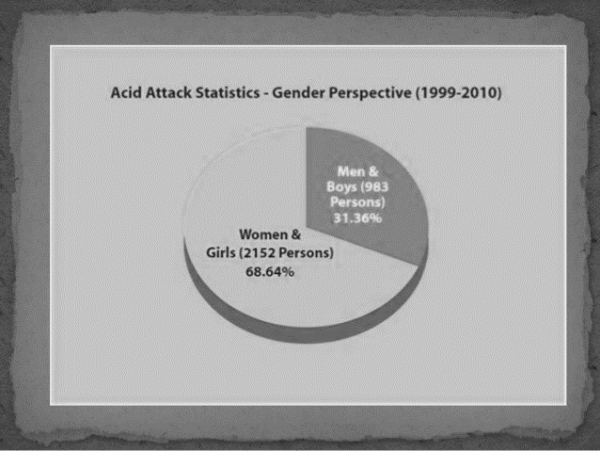GENDERED ASPECT IN ACID ATTACK

“Acid attack woman are not victims, they are
survivors. They change their faces not their dreams, they destroy their profile
not their imperishable soul”
-Loveship-
ABSTRACT:
India is a country
which reports approximately 200-300 acid attacks every year. The worst part is most
of the victims are women and children, as a result of rejection of marriage
proposals. Increasing acid attack towards women brought a gendered aspect in
this heinous crime. So the female has to be considered as the most vulnerable
section towards this inhuman activity. What are the reasons which increased
acid attack towards women? How can we control such crimes?
Important
points….
- Gendered
aspects
- Rate
of acid attack in India
- Women
and Men, ratio as victims
- Cause
and consequences of acid attack
- Increase
of acid attack in India
- Law
against acid attack in India and other countries
- Suggestions to reduce acid attacks
INTRODUCTION
Acid throwing also known as acid attack, or vitriolage.
It’s a form of assault which is defined
as the act of throwing acid onto another with an intention to disfigure the
body. Overwhelmingly in India, the victims of acid attack are women and
children. Hundreds of young women are becoming victims of this attack every year.
There are many reasons behind this dreadful crimes which extends from rejection
of marriage proposals to dowry issues. The number of acid attack shows that the
attack has now gained a women centered or a gendered aspect. The accumulation
of victims or sufferers are due to the ineffective laws or the lack of
implementation of proper laws which makes the people think of the after effects
if they commits such crimes.
GENDERED ASPECT
Acid attack nowadays has become a heinous crime especially against women. The criminals doesn’t aim in killing the victims but to left them in a state of physical and mental illness which follow them in their entire life. This are the results of rejection of marriage proposals and other sexual desires. [1]The male prefer to hurt female in 9 out of 10 times with acid because they love their beauty. They wanted to ruin the romantic future life of women which was rejected to him. He also wants to destroy her social status, career, economic background which made her more strengthen and rejected his proposals. In India, one third of women in age group 15-49 undergo physical violence,[2] but 2 out of 3 women will not share their experience with anyone.
There are 250-300 acid attacks cases reported in India
every year, among them most of the victims are women. Other crimes against
women like rape increased in the capital city from 572 -2,155 within 5years as
per Delhi police report.
TABLE: 1 ACID ATTACK STATISTICS-A GENDERD ASPECT
(1999-2010)

The diagram clearly show how the females are affected
more due to the inhuman acts of acid attack. There is a huge difference
existing between the number of male and females who are attacked.
CAUSE AND CONSEQUENCES
The depth of injury and the after effects depends upon
the intensity of the acid used and the time for which the victim had in contact
with the acid. The acid can cause complete destruction or damage to eye, ear,
nose and the inhaling of acid can also cause severe damage to lungs which
results in breathing problems and suffocation.
TABLE 2: REASONS FOR ACID ATTACKS

Above half (63%) had similar burns and the reason for
the attacks are refusal of marriage proposal, dowry, doubt on character, drug
addiction, marital affair.
[3]Majority of the victims (73%) had to face
psychological effects including ignorance of children, behavior of family and
relatives which are more painful than the physical injuries. Most of them are
self-isolated and are suffering from loneliness. The victims also becomes
unable to work and depends upon some others for their food and shelter.
Consequences also includes the negative attitude of the public towards them.
RISE OF ACID ATTACK IN INDIA
[4]According to National Crime Records Bureau it’s found
that the number of victims of acid attack have reached 1,483 between 2014-
2018.
[5]In 2012, 106 cases where reported in India according
to Acid Survivors Report in India (ASFI). In 2014, 244 cases where reported,
among them only 201 people where charge-sheeted. 2017-2018 showed a huge
increase in the acid attack cases which reached 596 in the year 2017, and 623
victims in the year 2018. [6]The
dreary part is only 19% people convicted in the cases.
TABLE 3: NUMBER OF CASES AND
CASES INVESTIGATED

Supreme Court in
the year of 2013 ordered government to limit sales of acid, but it’s scary to
know that these acids are still available in country to anyone even at a very
low cost. This shows the failure of the government to implement the laws which
are passed. The failure in implementing rules and prosecuting the criminals is
the root cause for the increase of acid attack every year.
[7]As per NFHS final report only 2% of abused women seeks
help from police, which is a major reason for the increase in the number of
crimes. This 2% who strive for justice in certain situations has to be
satisfied with the inefficiency and apathy of the legal system, those who
brought to book in rare cases are let go in name of bail. The increasing acid
attacks can be now concluded as the after effect of the legal system.[8]
India has to refer to certain laws of countries like Bangladesh which came up
with death penalty for the acid attack in, 2002. Pakistan provides the
perpetrator the same faith as of the victim and in Iran the attacker has to be
blinded. The strict rules followed by this countries made it possible to reduce
the number of acid attack as compared to India.
LAW AGAINST ACID ATTACK IN INDIA
India is a
country which has a huge increase in the number of acid attacks every year even
then ,until recent time there was no specific provision in India which deals
with this crime. 226th Law Commission and Justice J.S Verma
committee made suggestions on this behalf which paved way for the introduction
of specific provisions.
[9]Section 326A (provides 10yr of
imprisonment which may also extend to life imprisonment for causing grievous
hurt in acid attack) and 326B were added in Indian Penal Code which provide
punishment for acid attack and attempt for the same. Additional clause also
added in Section 100 which provides exception from criminal liability for
causing death in case of private defence in acid attack. [10]Indian
Constitution also provides protection against such crimes which is included
under fundamental rights.There is Prevention of Offence (by Acid) Act, 2008
which also provides the protection against acid attack.
CONCLUSION:
Acid attack is one of the most
dangerous crime which is now existing in our country. It's also to be noted that
the victims to this kinds of crimes are women due to different reasons. This
increase in the number of acid attack towards women brought a gendered aspect
for this kind of crimes. The only way to fight against or to protect our mother
and sister from this heinous crime is to implement new laws and strengthen
those laws which are already in existence. When compared to other countries
like Pakistan, Bangladesh the number of acid attacks are very less. This is due
to the strict rules which are existing in those countries. The punishment like
death penalty, blinding, and same effect as of victims etc. helped a lot in
reducing the crime in these countries.
So the only way reduce the attack in our country is to adopt similar kinds of
punishments, which makes the people scared and prevent them from doing similar
kind of crimes while thinking of this kind of punishments. The other way to
reduce the crime is to completely prohibit the availability of acid to people
in the country. So making strike rules on this behalf and implementing the same
more effectively can help to reduce the attacks in our society.
[1]
https://www.independent.co.uk/news/uk/home-news/acid-attacker-victims
[2]
https://www.who.int/news-room/fact-sheets/detail/violence-against-women
[3]
https://www.researchgate.net/publiction
[4]
Report of National Crime Records
Bureau,2017
[5]
Acid Survivors Report in
India,2012
[6]
https://www.indiatoday.in/diu/story/
[7]
https://thewire.in/women/domestic-violence-india-reporting
[8]
https://m.hindustantimes.com/india/acid-attacks-a-look-at-india-and-other-countries/
[9]
Criminal Law (Amendment) Act,
2013
[10]
Indian Constitution, 1950
